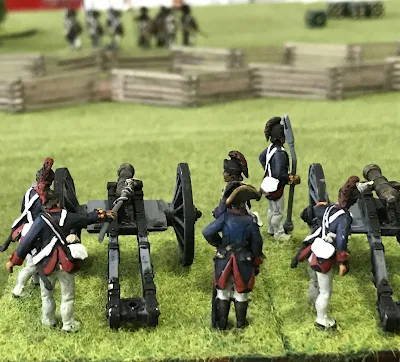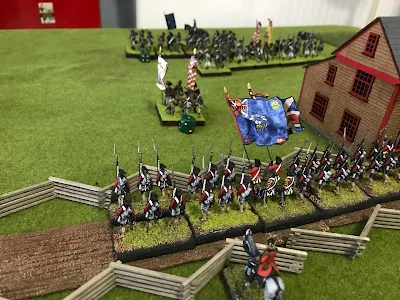The best way to learn a set of rules is to play those rules. So my son Nathaniel agreed to try a game. We set up a small scenario and started playing. The table was 6' x 5' with a cross road in the center. The two houses blocked fire but you could not put troops inside them.
The order of battle for both side were:
American Order of Battle:
General John Glover
3rd Continental Regiment (30 figures)
13th Continental Regiment (30 figures)
26th Continental Regiment (30 figures)
Militia battalion (30 figures)
Rifle battalion (12 figures)
Hamilton's Artillery battery (2 x 6pdrs)
3rd Continental Light Dragoons (6 figures)
British Order of Battle:
General Lord Rawdon
23rd Regiment (30 figures)
33rd Regiment (30 figures)
49th Regiment (30 figures)
Legion Light Infantry
17th Light Dragoons
Royal Artillery (2 x 6pdrs)
The British set up in the center and marched forward. The 23rd, Royal Artillery and 49th with the 33rd in reserve. The Lights and cavalry advanced up the right side of the table to try and turn the American flank.
The Americans sent the 3rd Continental and Rifles down their right flank to out flank the British. The Artillery took position in a hill by the British right flank opposed the lights and cavalry. In the center the 13th, 26th and militia hoped to hold on while the rest of the army enveloped the British .
We rolled to see who moved first and Nathan won. Turn sequence is check morale, move, fire and after fire movement for first player then second player . Nathan moved his artillery into two great positions. One on top of a hill and the other looking down the road. Both have great views of the British and clear fields of fire. At this point In the game we both made a error. Artillery can move and fire in a turn. Light guns can move 6" or move and fire 3" and can fire out to 36" . Heavy guns move 3" or 1" and fire and range out to 4 8" . Unfortunately we decided they were heavy guns but moved them as Light guns and fired as heavy. Part way through the game we discovered this. Artillery was very devastating, possibly because of this. We will do better next time.
The battle started with American artillery targeting the British lights at close range. When you fire artillery you first roll to see if you hit the target. Roll one dice and point out where you are aiming. Close range is either a misfire if you roll a one otherwise hit. You then place a block 4" x 2" centered on where you hit and you roll for the figures within it up to six figures. Each figure hit gets a saving roll. Regular infantry save on a 5 or 6 but at close range you lose one pip so save on a 6 only. Poor rolling saw the light take four hits and then failed the morale check .
The British guns stayed together and concentrated their fire on the 26th Continental. We found it important at medium or long range to aim at a point where is you hit it causes the most damage as the aiming roll could send the shot slightly the right or left of aiming point. This possibly missing the target or only hitting a small amount of figures.
After a couple turns most regiments got within small arms range. The American rifles had superior range but we're slower to reload so fired every other turn. Light troops could also split move (move - fire - move) but Nathan did not try that. by this time my Lights had routed off the board due to casualties from artillery fire. To fire small arms you count up the figures, check the range and in the small arms chart see how many possible hits. The target gets to roll a saving roll for each possible hit. Note that if you are behind cover (walls etc) you add one to the saving roll. So if you save on a 5 or 6 if under cover you save on a 4, 5, or 6. Regiments can move and fire.
In the center the two British line regiments and two guns decimated the 26th Continental which routed. The American guns continued to cause long range hits in the British 49th regiment.
The American cavalry moved around the British flank and charged the British cavalry. In a melee both sides throw a dice, add or subtract modifiers and multiple by number of figures. High side wins. Loser take a 20% casualties and retired. Winer take a 10% casualties from front rank. The Americans easily drove off the British dragoons and then turned against the British center.
By this time the British were in trouble. Their lights and cavalry were gone. American cavalry were moving against their right. On the left the American 3rd Continental and Rifles were turning that flank. The 49th were taking heavy casualties due to Artillery fire. But marching steadily onward the British 23rd and artillery took on the 26th (which had rallied and returned) and broke them. They then routed the Militia battalion. Soon only the 13th Continental stood in their way. The 49th and 33rd turned to protect their left flank. In the small arms exchange the 49th was down to less then 50% and failed their morale check. As they retreated the 33rd charged the 3rd in a attempt to turn the battle. But it was not to be. They rolled very poorly ( a 1) and the Americans rolled very well (6) so they lost lost the melee. Athough the British 23rd were advancing victorious the rest of their forces were in retreat. With over 50% losses the game was called and declared a American victory. Well done Nathaniel!
It was a fun game and were learned a lot. For next time I think a cheat sheet for both players will be very useful. We will be trying another game soon.















Great commentary and useful guide for the rules (especially artillery). The rules look very good, and your playtest emphasises the key aspects - great stuff. Yes, a cheat sheet is something I'll have to look at too.
ReplyDeleteI sense that Nathaniel's victory will generate that burning need for a re-match :)
Thank you. This was point of the exercise to actually learn The rules and point out his to play for others who were interested in trying them out.
DeleteThanks Mark, lovely sized encounter.
ReplyDeleteThank you. I think next time we might try a small game with just three infantry battalions. Then on the same board play again but are first a light infantry unit then a artillery gun. This way we get to concentrate on learning parts of the rules better. Very Featherstone like.
DeleteGreat report and thanks for the copy of the rules you sent through. Your son certainly has an appropriate name for a competent American Revolutionary general!
ReplyDeleteI worry that Janine will figure out I named our son after a American Rev War general. She thinks she picked out the name!😁
ReplyDelete